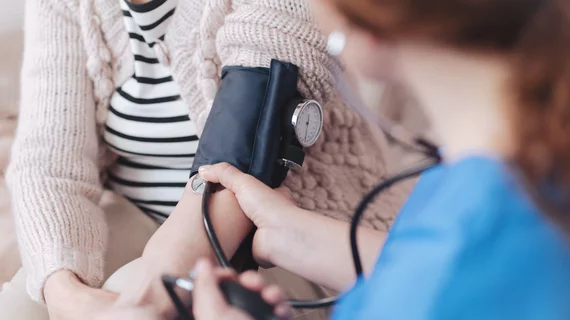Though many physicians are reluctant to change the status quo, a study published in JAMA Internal Medicine Feb. 4 suggests automated office blood pressure measurement (AOBP) is the way to go when recording a patient’s BP, since the approach bypasses the so-called “white coat effect” triggered by more traditional methods.
Since some patients experience blood pressure spikes when they’re in a doctor’s office—mostly due to nerves—physicians now recognize ambulatory BP monitoring (ABP) as the best method for predicting a patient’s risk of BP-related cardiovascular events like hypertension, Michael Roerecke, PhD, and co-authors wrote in JAMA. ABP avoids the possibility of anxiety-induced high BP readings by recording a person’s blood pressure remotely for 24 or 48 hours at a time, both while they’re awake and moving and while they sleep.
“Although the accurate measurement of BP is the cornerstone for appropriate diagnosis and treatment of hypertension, recent guidelines have questioned the accuracy, and consequently the role, of manual BP measurement in routine clinical practice,” Roerecke and colleagues wrote. “Routine office BP measurement is not only more susceptible to a ‘white coat effect’, but is also less accurate, correlating relatively poorly with the awake ABP, and is more likely to be associated with digit preference (rounding off readings to the nearest zero value).”
The recent advent of the oscillometric sphygmomanometer offered a new solution, the authors said. The tech was designed in part for patient use, so people could measure their own BP in a non-threatening home environment, but some physicians have used certain oscillometric recorders to measure a patient’s BP in a clinical setting, without the need to have anyone else in the room with them.
Roerecke et al. explained that office staff do initiate a patient’s readings in the latter situation, but a built-in delay in the recorder allows patients some time to relax before automatic measurements begin. The process is known as automated office blood pressure measurement, or AOBP.
“The most important innovation with this technique was that conversation between the patient and office staff was no longer possible because the patient was alone, as talking was known to be a major cause of the white coat effect,” the authors wrote. “Also, removing clinic staff likely reduces any anxiety caused by the presence of nurses or physicians.”
The team launched their own meta-analysis of AOBP’s efficacy against traditional methods like awake ABP monitoring, routine office BP measurement and research BP measurements. They included studies logged in the Cochrane Library, Embase and MEDLINE databases that compared AOBP with another BP measurement method and enrolled at least 30 patients.
Roerecke and colleagues compiled data from 31 articles comprising 9,279 participants (4,736 men and 4,543 women). In samples with a systolic AOBP of 130 mm Hg or higher, routine office and research systolic BP readings were “substantially” higher than AOBP readings, with a pooled mean difference of 14.5 mm Hg for routine office systolic BP readings and 7 mm Hg for research systolic BP readings.
The authors reported systolic awake ABP and AOBP readings were similar, with a pooled mean difference of just 0.3 mm Hg across studies. Systolic AOBP differed from systolic awake ABP by more than 5 mm Hg in just two articles.
Roerecke et al. said that when AOBP was recorded properly, meaning patients had to be sitting alone in a quiet place when their BP was measured, it was a more accurate method for detecting hypertension. The team advocated for AOBP’s adoption as the preferred method for recording BP in routine clinical practice, but acknowledged it would have to be done carefully.
“If AOBP is to be used in clinical practice, readings must closely adhere to the procedures used in the AOBP studies in this meta-analysis, including multiple BP recordings recorded with a fully automated oscillometric sphygmomanometer while the patient rests alone in a quiet place,” the team wrote. “Using this approach, AOBP has been the preferred technique for office BP measurement in the evidence-based Hypertension Canada guidelines since 2016 and is now routinely used by many Canadian primary care physicians.”

